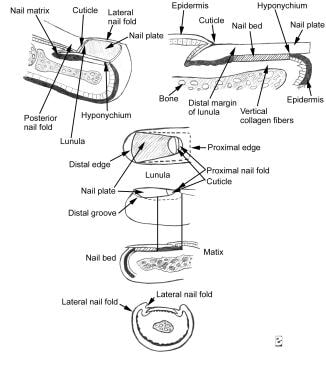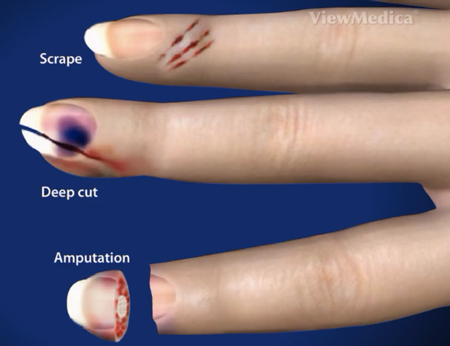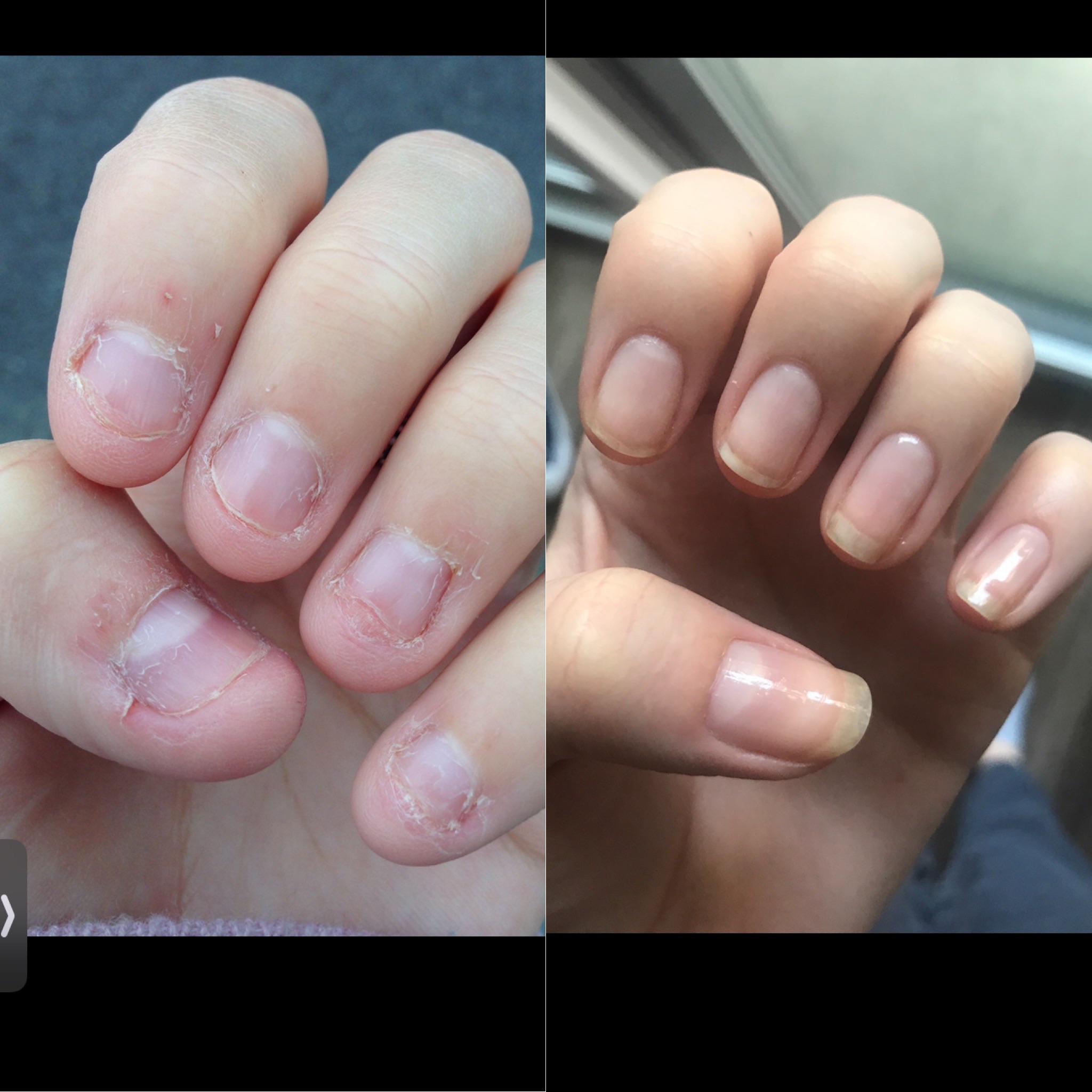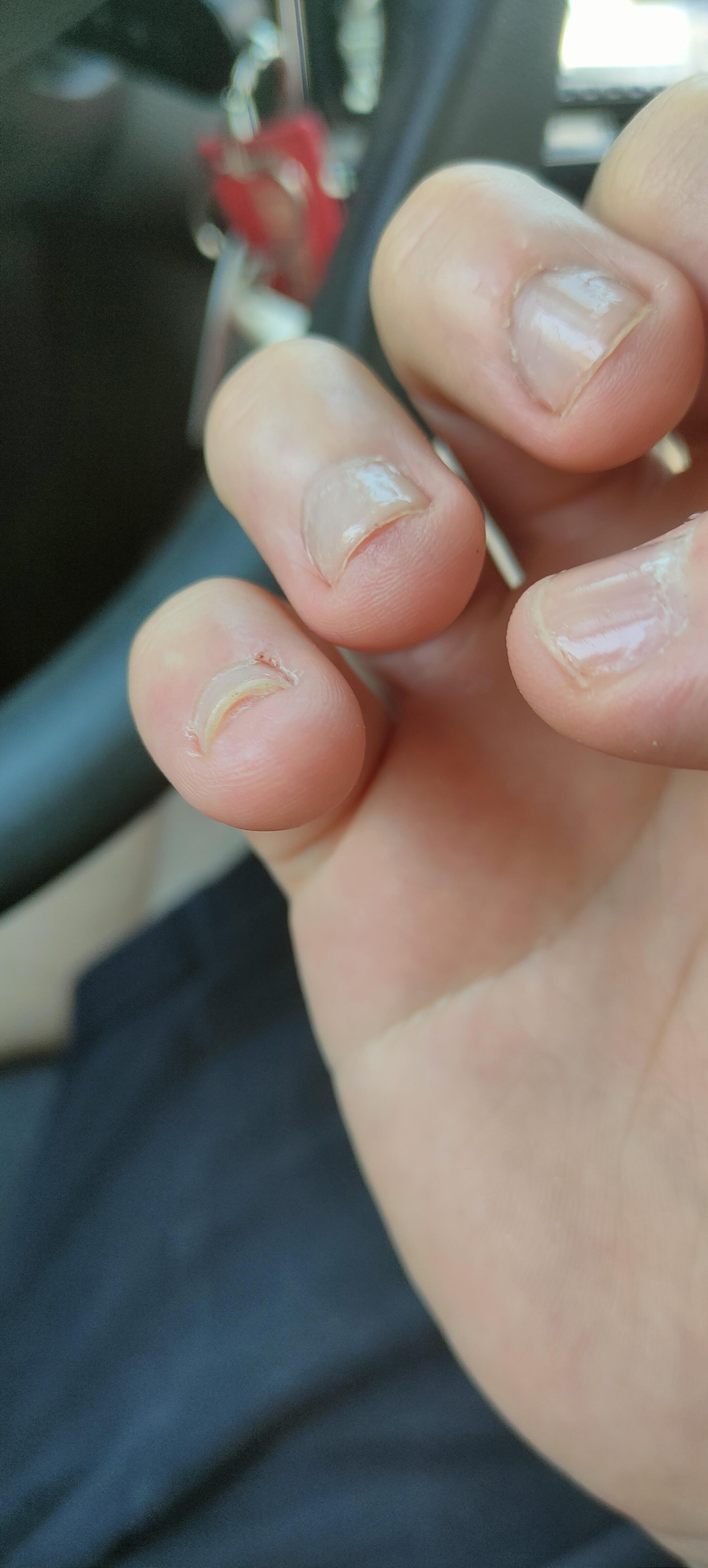Understanding The Nail Bed: Structure And Function

The nail bed is an essential component of the nail unit, serving as the foundation for nail growth and protection. It is a specialized structure located beneath the nail plate, extending from the nail matrix, where nail cells are produced, to the tip of the finger. The nail bed consists of multiple layers of keratinized cells that give the nail its strength and durability. It also contains blood vessels and nerve endings, which contribute to the sensation and blood supply of the fingertips. The nail bed plays a crucial role in maintaining nail health and function.
1 Anatomy Of The Nail Bed
The nail bed is a specialized structure located beneath the nail plate, extending from the nail matrix to the tip of the finger. It consists of multiple layers of keratinized cells that provide strength and durability to the nail. The nail bed also contains blood vessels and nerve endings, which contribute to the sensation and blood supply of the fingertips. This structure plays a crucial role in maintaining the health and function of the nail, providing the foundation for nail growth and protection. The anatomy of the nail bed is essential to understand the healing process and potential for regeneration.
2 Functions Of The Nail Bed
The nail bed serves several important functions in the overall health and wellness of the nail.
- Nail Growth: The nail bed houses the nail matrix, which is responsible for the production of new nail cells. These cells move forward along the nail bed, pushing the older cells forward and contributing to the growth of the nail plate.
- Sensation: The nail bed contains numerous nerve endings, making it highly sensitive to touch, pressure, and temperature. This allows us to feel and perceive sensations through our fingertips.
- Blood Supply: The nail bed is also rich in blood vessels, providing nourishment and oxygen to the nail plate. These blood vessels play a vital role in maintaining the health and color of the nails.
Overall, the nail bed plays a crucial role in nail growth, sensory perception, and blood supply, contributing to the overall function and appearance of the nails.
Common Nail Bed Injuries And Conditions

Common nail bed injuries and conditions can range from minor to severe, impacting the overall health and appearance of the nails. Some common injuries and conditions include:
- Subungual Hematomas: These occur when blood vessels under the nail bed rupture, causing blood to pool between the nail and the nail bed. They usually result from trauma or injury to the nail.
- Nail Avulsion: This refers to the partial or complete separation of the nail from the nail bed. It can occur due to trauma, fungal infections, or other underlying medical conditions.
- Ingrown Nails: When the nail grows into the surrounding skin, it can cause inflammation, pain, and infection. Ingrown nails often occur due to improper nail trimming or tight footwear.
- Nail Psoriasis: Psoriasis can affect the nail bed and result in nail pitting, discoloration, and crumbling. It is a chronic autoimmune condition that affects the skin and nails.
- Paronychia: This is an infection of the skin around the nail, usually caused by bacteria or fungi. It can cause swelling, redness, pain, and pus formation.
Proper diagnosis and timely treatment by a healthcare professional are essential for managing and resolving these nail bed injuries and conditions.
1 Nail Bed Injuries: Causes And Types
Nail bed injuries can occur due to various causes, including trauma, accidents, repetitive use, or underlying medical conditions. These injuries can range from minor cuts and bruises to more severe conditions such as nail avulsion or subungual hematomas. Trauma, such as crushing or slamming a finger, is a common cause of nail bed injuries. Other causes include improper nail care, fungal infections, and systemic conditions like psoriasis. It’s important to seek prompt medical attention for severe injuries and to practice proper nail care to prevent these types of injuries.
2 Nail Bed Infections And Disorders
Nail bed infections and disorders can cause significant discomfort and affect the overall health of the nails. Some common nail bed infections include fungal infections, paronychia, and onychomycosis. Fungal infections can lead to thickened, discolored nails, while paronychia causes redness, swelling, and pain around the nail bed. Onychomycosis is a fungal infection that can result in brittle, crumbly nails. Other nail bed disorders include nail psoriasis, which causes pitting, ridges, and discoloration of the nails, and nail clubbing, characterized by the enlargement of the fingertips and curved nails. Prompt diagnosis and treatment are crucial in managing these infections and disorders and preventing further complications.
Can The Nail Bed Grow Back? Exploring Regeneration Potential

The regrowth potential of the nail bed depends on various factors. While the nail bed has the ability to regenerate, its regrowth may vary based on the extent and nature of the injury. In cases where the nail matrix, the area responsible for nail growth, is intact, the nail bed can regenerate more effectively. Conversely, if the nail matrix is severely damaged or absent, the regrowth of the nail bed may be compromised. Full-thickness skin grafts or flap coverage can enhance nail bed regeneration. However, further research is needed to fully understand the regenerative capacity of the nail bed.
1 Factors Affecting Nail Bed Regrowth
Various factors can affect the regrowth of the nail bed after an injury. Some of these factors include the severity and extent of the injury, the presence of infection, the overall health and condition of the individual, and the proper wound care and maintenance. Additionally, underlying medical conditions such as diabetes or autoimmune disorders can also impact the regenerative capacity of the nail bed. Adequate nutrition and a healthy lifestyle can play a role in promoting nail bed healing and regrowth. It is important to consult a healthcare professional for proper assessment and guidance in promoting nail bed regrowth.
2 Nail Bed Regeneration Process
The process of nail bed regeneration involves several steps that occur over time. After an injury or trauma to the nail bed, the body initiates a healing response. The damaged tissues undergo a process called granulation, where new blood vessels are formed and the wound fills with connective tissue. Epithelial cells then migrate from the edges of the injury to cover the granulation tissue, forming a new layer of skin. As the skin continues to heal, new nail tissue begins to grow from the matrix, which is located at the base of the nail bed. This process of regeneration can take several weeks to months, depending on the severity of the injury and the overall health of the individual. Adequate wound care and proper nutrition can support the regenerative process and promote the growth of healthy nail tissue.
Tips For Promoting Nail Bed Healing

To promote healing of the nail bed, proper wound care is essential. Here are some tips to facilitate the healing process:
- Keep the injured area clean: Wash the affected nail bed gently with mild soap and warm water. Pat it dry with a clean towel.
- Protect the nail bed: Cover the injured nail bed with a sterile bandage or dressing to keep it clean and prevent infection.
- Avoid unnecessary trauma: Refrain from picking, pulling, or biting the healing nail bed. This can disrupt the regrowth process and delay healing.
- Maintain good hygiene: Trim your nails regularly and keep them clean to prevent further damage or infection.
- Eat a balanced diet: Ensure you’re getting adequate nutrients, especially vitamins and minerals essential for nail health, such as biotin, zinc, and iron.
- Avoid harsh chemicals: Limit the use of nail polish removers and avoid exposing the injured nail bed to harsh chemicals that can impede healing.
Remember, patience is key when it comes to nail bed healing. Following these tips and seeking appropriate medical care will help ensure optimal recovery.
1 Proper Wound Care For Nail Bed Injuries
Proper wound care is crucial for promoting healing of nail bed injuries. It is important to keep the injured area clean by gently washing the affected nail bed with mild soap and warm water. After washing, pat it dry with a clean towel. To protect the nail bed and prevent infection, cover it with a sterile bandage or dressing. Avoid unnecessary trauma by refraining from picking, pulling, or biting the healing nail bed. Maintaining good hygiene, such as regularly trimming and cleaning the nails, can also aid in the healing process.
2 Nail Bed Health Maintenance
Proper maintenance of the nail bed is essential for overall nail health. Regularly trimming and shaping the nails can help prevent injuries and damage to the nail bed. Maintaining good hygiene by washing the hands regularly and keeping the nails clean can also promote nail bed health. Avoiding harsh chemicals, such as acetone-based nail polish removers, can prevent damage to the nail bed. Additionally, using moisturizers and cuticle oils can keep the nail bed and surrounding skin nourished and hydrated. By taking these simple steps, individuals can maintain a healthy nail bed and support the overall health of their nails.
Medical Interventions And Treatments For Nail Bed Healing

Medical interventions and treatments for nail bed healing may be necessary depending on the severity and type of injury. Minor nail bed injuries, such as subungual hematomas, often heal on their own. However, in cases where professional treatment is required, it can help ensure proper healing and the formation of a smooth surface for the new nail to grow. Some medical interventions for nail bed healing include:
- Surgical options: In severe cases, surgical intervention may be necessary to repair the nail bed and promote healing. This may involve removing the damaged nail and repairing the underlying structures.
- Non-surgical interventions: Non-surgical treatments, such as antibiotic ointments or oral antibiotics, may be prescribed to treat nail bed infections. In addition, splinting or taping the injured nail may be recommended to promote proper alignment and healing.
It is important to consult with a healthcare professional for guidance on the appropriate medical interventions and treatments for nail bed healing.
1 Surgical Options For Nail Bed Injuries
In severe cases of nail bed injuries, surgical options may be necessary for proper healing. Surgical intervention often involves removing the damaged nail and repairing the underlying structures of the nail bed. This procedure helps to promote the growth and formation of a new nail. Surgical options for nail bed injuries are typically performed by a healthcare professional, such as a dermatologist or a hand surgeon. It is important to seek medical advice and guidance to determine if surgical intervention is necessary and to ensure the best outcomes for nail bed healing.
2 Non-surgical Interventions For Nail Bed Conditions
Non-surgical interventions for nail bed conditions focus on promoting healing and preventing further damage without the need for invasive procedures. These interventions may include:
- Topical medications: Applying antibiotic creams or ointments can help prevent infections and promote healing in nail bed injuries. These medications may contain ingredients such as bacitracin, neomycin, or mupirocin.
- Protective dressings: Placing a protective bandage or dressing over the affected nail bed can help prevent further trauma and promote healing. These dressings can provide a barrier against bacteria and keep the area clean.
Overall, non-surgical interventions aim to support the natural healing process of the nail bed without the need for surgical intervention.
Conclusion

In conclusion, understanding the healing potential of the nail bed is crucial for proper care and maintenance. While the nail bed has the ability to regenerate, the process may be affected by various factors such as age and underlying medical conditions. It is important to practice proper wound care for nail bed injuries and maintain overall nail health to promote healing. Additionally, medical interventions, both surgical and non-surgical, can aid in the healing process. By taking proactive steps to care for the nail bed, individuals can ensure optimal nail health and promote successful regeneration.
1 Understanding Nail Bed Healing Potential
Understanding the healing potential of the nail bed is crucial for proper care and maintenance. While the nail bed has the ability to regenerate, the process may be affected by various factors such as age and underlying medical conditions. It is important to practice proper wound care for nail bed injuries and maintain overall nail health to promote healing. Additionally, medical interventions, both surgical and non-surgical, can aid in the healing process. By taking proactive steps to care for the nail bed, individuals can ensure optimal nail health and promote successful regeneration.
2 Importance Of Nail Bed Care And Maintenance
Proper nail bed care and maintenance are essential for overall nail health and well-being. By taking proactive steps to care for the nail bed, individuals can ensure optimal healing and regrowth potential. Some reasons why nail bed care and maintenance are important include:
- Preventing infections: Keeping the nail bed clean and free from debris helps reduce the risk of infections, which can impede healing and hinder nail regrowth.
- Promoting circulation: Massaging the nail bed can stimulate blood flow, delivering essential nutrients and oxygen to support healing and promote nail growth.
- Maintaining nail strength: Regularly moisturizing the cuticles and nail bed helps prevent dryness and brittleness, keeping the nails strong and less prone to breakage.
- Minimizing damage: Proper nail care techniques, such as avoiding excessive nail biting or picking, can prevent damage to the nail bed, promoting healthy regrowth.
Overall, investing time and effort in nail bed care and maintenance is crucial for promoting optimal healing, regrowth, and maintaining healthy and beautiful nails.
FAQ: Does Nail Polish Expire?
Q: Does nail polish expire?
A: Yes, nail polish does expire after a certain period of time.
Q: How can I tell if my nail polish is expired?
A: There are a few signs to look out for to determine if your nail polish has expired. If the color has changed, has become thicker or stringy, or has a strong and unpleasant smell, it is a good indication that the nail polish is past its prime.
Q: What happens if I use expired nail polish?
A: Using expired nail polish may result in a less than desirable outcome. The polish may not apply smoothly, may streak, or clump on the nails. Additionally, the color may not be true to what you see in the bottle.
Q: How long does nail polish typically last before expiring?
A: On average, nail polish has a shelf life of one to two years. However, this can vary depending on the brand and the quality of the product. Some polishes may last longer, while others may expire sooner.
Q: How can I extend the lifespan of my nail polish?
A: To increase the longevity of your nail polish, make sure to store it properly. Keep it away from direct sunlight, extreme temperatures, and humidity. Also, ensure that the cap is tightly closed after each use to prevent the polish from drying out.
Q: Can I still use separated or dried out nail polish?
A: If your nail polish has separated or dried out, you may still be able to salvage it. Try gently rolling the bottle between your hands to mix the ingredients. If necessary, you can also add a few drops of nail polish thinner to restore its consistency. However, if the polish remains clumpy or streaky even after attempting to revive it, it is best to discard it.
Q: Can I use old nail polish on my nails if it’s still in good condition?
A: If the nail polish is unexpired and has no noticeable changes in color, smell, or consistency, then it is usually safe to use. However, ensure that your nails are in good condition and that you have properly sanitized your tools before applying any nail polish.
Q: Is it bad for my nails to use expired nail polish?
A: Using expired nail polish is not necessarily harmful to your nails, but it may not provide the best results. It is generally recommended to use fresh and unexpired nail polish for optimal performance and color payoff.
Q: What should I do with expired nail polish?
A: It is best to dispose of expired nail polish responsibly. Check with your local waste management guidelines on how to properly dispose of chemicals or hazardous waste. Avoid pouring nail polish down the drain or throwing it in the regular trash bin.
In summary, nail polish does have an expiration date, typically lasting one to two years. Using expired nail polish may result in less satisfactory results, such as streaking or clumping. To extend the lifespan of your nail polish, store it properly and keep the cap tightly closed after each use. If your nail polish has significantly changed in quality or consistency, it is best to dispose of it and use fresh nail polish for the best outcome.

I am proud to offer non-toxic beauty options. The gel polishes I offer are “9-Free”, free of nine of the most commonly found allergens and toxic chemicals in nail polish, and cruelty-free, vegan, and HEMA-free. The nail lacquers I offer range between “7-Free” and “16+-Free” and are also cruelty-free and vegan.